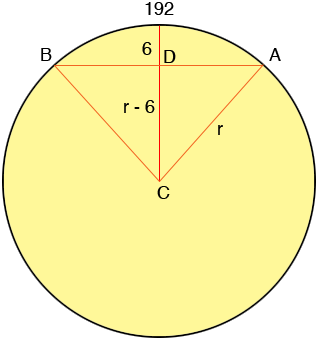| |||
| Math Central | Quandaries & Queries |
|
Question from Ned: Given an arc with length of 192 inches (don't know chord length), and arc height of 6 inches, how would one find the radius? |
Hi Ned,

In my diagram if the measure of the angle BCA is θ radians then the length of the arc AB is given by r × θ and hence
192 = r × θ
Also from triangle DCA
cos(θ/2) = (r - 6)/r
Putting these two equation together gives
cos(192/(2r)) = (r - 6)/r or
cos(96/r) = (r - 6)/r
Unfortunately this equation can not be solved algebraically for r, the best you can do is approximate r. If you let
f(r) = cos(96/r) - (r - 6)/r
then you are looking for a root of f(r), that is a value of r so that f(r) = 0.
One approximation technique is newton's method but even here there are some pitfalls. Newton's method requires an initial guess and because of the oscillatory nature of the cosine function your equation has multiple positive roots and a poor initial guess might lead you to the wrong root. Since the sagitta is so small, we know that θ < π radians, so given that the arc is 192, then r ≥ 192/π, which provides us with a suitable initial guess for newton.
Newton's method applied to your problem yields r = 767 inches and hence θ = 192/767 = 0.2503 radians which is 45.05 degrees.
Stephen La Rocque and Harley Weston
 |
||
Math Central is supported by the University of Regina and The Pacific Institute for the Mathematical Sciences.